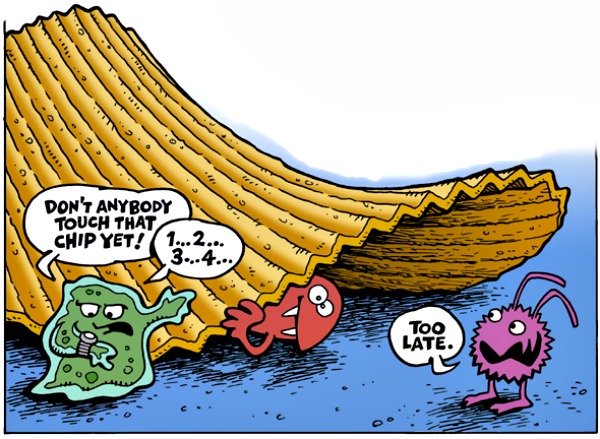Who knows why we sometimes believe things that are false? Maybe we don’t like the truth. Maybe it’s easier to believe the myth. Maybe we’re unable to determine the truth. Maybe the story has been accepted so long that no one bothers to question it anymore.
 Science is filled with myths and commonly accepted untruths. Take the one called the “5 second rule.” We’re comfortable with that. It makes us feel better about picking-up something off the kitchen floor and eating it. The truth is that germs stick to things immediately. If there is salmonella present, which is frequently found in the kitchen, it will stick to the food immediately.
Science is filled with myths and commonly accepted untruths. Take the one called the “5 second rule.” We’re comfortable with that. It makes us feel better about picking-up something off the kitchen floor and eating it. The truth is that germs stick to things immediately. If there is salmonella present, which is frequently found in the kitchen, it will stick to the food immediately.Another commonly accepted belief is that lightning doesn’t strike twice in the same place. Actually, it happens quite frequently. The Empire State Building is struck an average of twenty-five times per year. Tall targets are hit more often than others are.
It is somewhat startling to think that we only use ten percent of our brains. The fact is that we use all parts of our brain in some way or another. What we don’t use to its full capacity is our intellectual ability.
We have been told that brain cells don’t regenerate, but in 1998 scientists discovered that our learning and memory centers can do so. Recently stem cell research has discovered a way that embryonic stem cells can morph into brain cells.
Have you ever heard that a penny dropped from a tall building can reach a velocity that will enable it to kill someone that it hits on the ground? Have no fear. The size and aerodynamics of the penny will not allow such a tragedy.
Is a car the best place to be during a lightning storm because the rubber tires will protect you? In truth, it is the metal exterior of the car that will act as a conductor, passing the electrical charge to the ground.
We’ve all heard that sugar makes kids hyperactive. The truth is that scientists can find no evidence for that assumption. Of course, we know that there are links between sugar consumption and obesity.
It is a common myth that after we die our fingernails and hair continue to grow. Cells need a constant supply of fuel produced by the ingestion of food in order to grow. They also need blood being pumped to them by the heart.
If you think that bats are blind, you are mistaken. They do rely on other sense like hearing and smelling more than some animals, but they can see. Their advanced sound based system of echolocation allows them to hunt nearly invisible prey in the dark.
Parents and kids, hoping for better things to come for themselves, like the story about Albert Einstein’s having flunked math class. Records of his academic life show that he was actually a good student which contradicts the popular myth.
Now it’s up to you to believe it or not.
(Source: Discovery Channel website)
